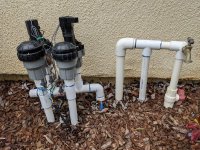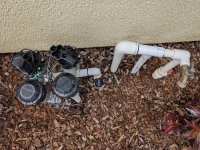Bannerman
Well-Known Member
My suggestion was to use 1 expansion tank located on the irrigation supply line to provide double duty to cushion the water hammer issue as close as possible to the source of the water hammer, and also address the water heater expansion issue when a backflow device is eventually installed on the incoming line from the city supply. For the expansion issue, the location of the X-tank within the plumbing system is not important as long as there is no check-valve or other backflow prevention device or isolation valve located between the WH & X-tank.
As your home is not equipped with a booster pump to raise water pressure, there is no other reason the plumbing pressure is unusually high, even while water is flowing from a faucet. The source of the high pressure must be from the city, which appears to be an intermittent problem they may not be yet aware of.
As your home is not equipped with a booster pump to raise water pressure, there is no other reason the plumbing pressure is unusually high, even while water is flowing from a faucet. The source of the high pressure must be from the city, which appears to be an intermittent problem they may not be yet aware of.


